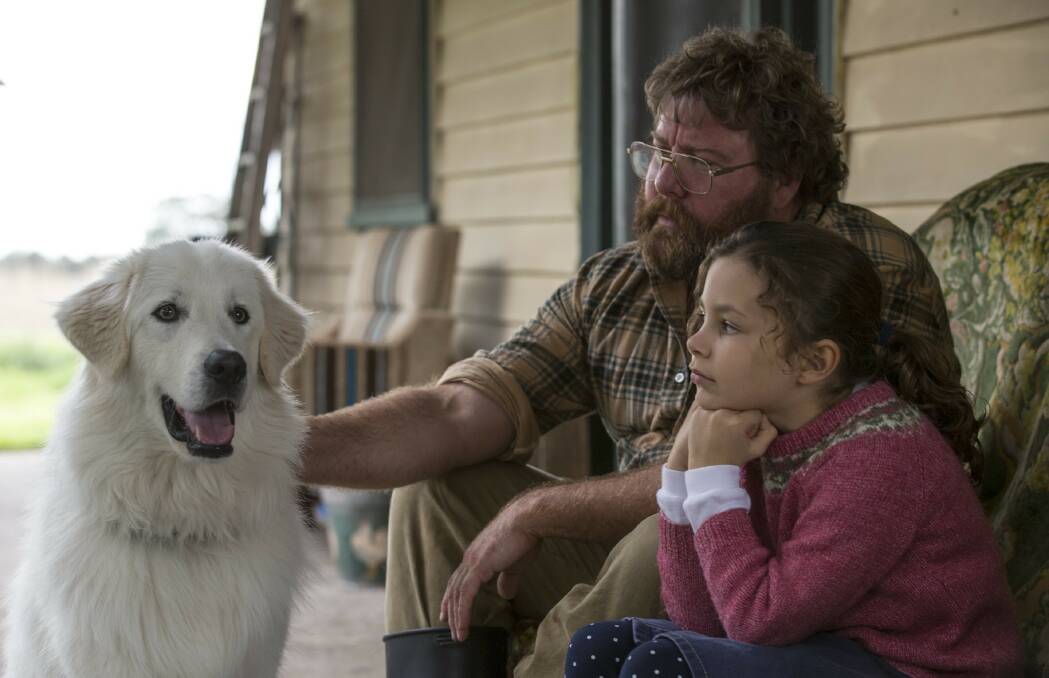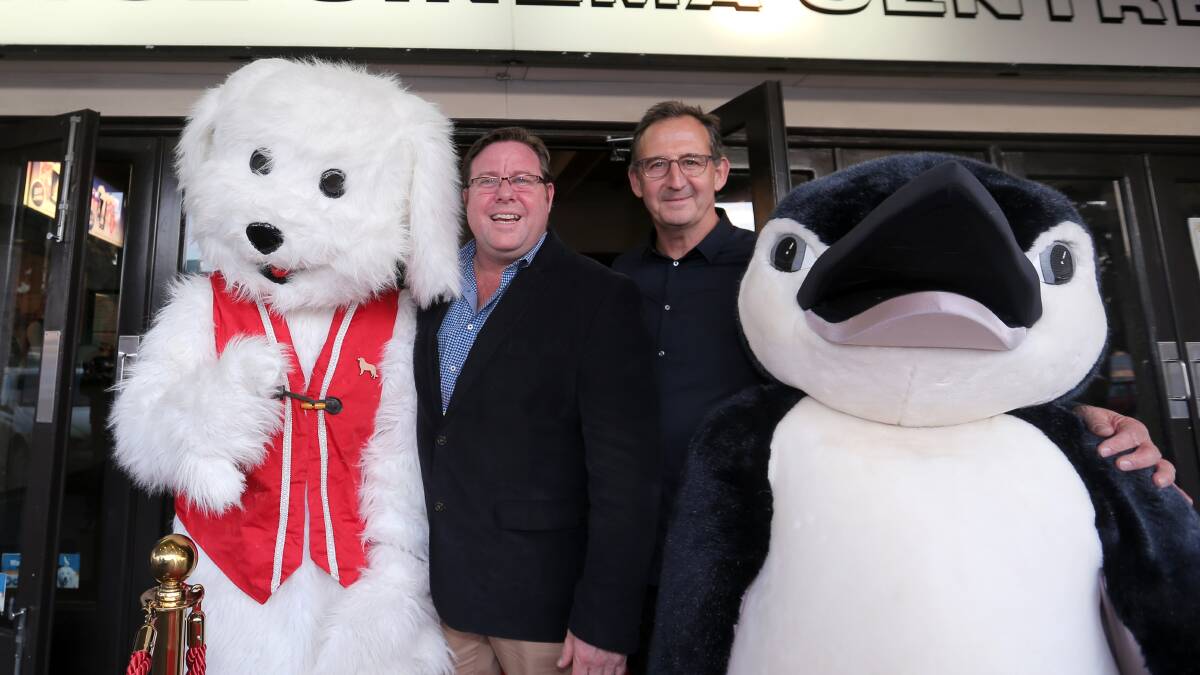
Everyone associated with Oddball knows the old showbiz rule about never working with animals and children. But everyone who worked on this based-on-fact story of an Australian chook farmer whose dog helped save a colony of penguins from fox attack also knows that rules are meant to be broken.
Subscribe now for unlimited access.
or signup to continue reading
"It was kind of a foolhardy thing to tell that story with real penguins and a real dog; foxes are even harder, and chickens ain't easy," admits Stuart McDonald, the veteran TV director (Summer Heights High, Tangle, Suburgatory) who makes his feature debut with the $7 million family film. "A lot of people shy away from putting children in major roles as well [child star Coco Gillies plays the chook farmer's granddaughter]. And we decided to take it all on in an orchestra of hard-to-do things."
Thankfully, he says, "the stars really did align with this".
RELATED:
It could so easily have gone wrong, though, as producer Richard Keddie concedes. More than five weeks into the seven-week shoot, they still hadn't filmed a penguin. When the big day came, he says, "I was sitting there going, 'If we don't get this shot we haven't got a movie'. It's really simple. We don't have a budget for computer-generated penguins."
With these little critters, he says, "You don't rehearse; you get the shot". Or not. For what seemed like an eternity after the cameras started rolling, "nothing happened". And then, Keddie says, "this little head pops over the ledge, and they were perfect".
The story of how Allan "Swampy" Marsh set his dog Oddball to work protecting the penguin colony of Middle Island, a few hundred metres off the windswept coast of western Victoria, is the stuff of legend. Locals – not to mention Tourism Victoria – will be delighted to see how much use McDonald has made of the stunning coastline (the not-quite-Twelve Apostles, Loch Ard Gorge, and the town of, and farmland around, Warrnambool all get the sweeping helicopter treatment). But the scenes on the island were mostly shot on a fabricated set in the Docklands Studios in Melbourne.
"We weren't allowed to film the penguins down there [in Warrnambool]," Keddie says. "We couldn't, because they'd run away. I had this idea of putting chicken wire around them but they jump and flip and flop."
The penguins in the film were in fact bred in captivity, at Sea World on the Gold Coast, and flown to Melbourne for the shoot.

They're tiny, which means the actors had to be super-careful around them. "When you think about it, they're living in the land of the giants," says handler Katie Brock.
Up at Sea World, they're not really performers, but here they were centre stage.
"Little penguins [as fairy penguins are properly known] do very little in a captive situation," Brock says, "so this is their big chance to shine."
Penguins take surprisingly well to direction, she says. "They're a flocking bird, so if we keep a caller bird at one end, they're constantly trying to get back together."
Entice one of them with a sardine, McDonald adds, and the rest will follow. "They're like magnetic particles that want to get back together again."
One penguin in particular, a young male called Chip who'd had no luck attracting a mate at Sea World, stood out. "He was a really amazing on-screen actor," McDonald says. "I noticed him and started featuring him more, and I think the girl penguin, Edith, was somehow impressed that he was being singled out."
Perhaps inevitably, they hooked up and now have a baby. Was it conceived on set? "It's hard to say, but probably," McDonald says. "I don't want to be one of those kiss-and-tell directors, but I was pretty much Chip's wingman."
As for shooting the hero of the story, that posed a whole other set of challenges. The real-life Oddball is a maremma, a type of Italian sheepdog that has been bred to be left out in a field on its own to protect the flock.
Shane Jacobson, who plays Swampy Marsh, is a huge fan of the maremma. "They're an amazing dog, the fact they can look so cute and also serve a purpose – that's what the film is all about," he says. "It's amazing that nature has put a little bouncer in place, a little protecting angel for things like penguins and chickens and sheep.
"Foxes have their own thing to do, but the fact there's this dog that goes, 'I understand that is apparently the earth's plan, but I just don't think it's fair and I'm going to stop that', it's like this one breed of dog has been raised by the Salvation Army and it's going to go out and do the right thing. It's just in their marrow."
McDonald says maremmas are decidedly independent and "don't need human approval like a lot of other dogs". "They're like, 'I don't really care', and that's a difficult psychology to work with.
"As a director, you pretty much have to start thinking of things from the dog's perspective. 'OK, I know what I want to achieve here, so how about we smear a bit of good-smelling stuff on Shane's beard so he licks him?'"
Wait: you really did that? "Yeah. Sort of a meat paste."
The real Swampy Marsh used Oddball to guard his chickens from foxes, before coming up with the idea of putting the dog out on Middle Island to help protect the penguins that were being attacked by feral animals.
In the film, Oddball is played by a maremma called Kai, which was rescued by trainer Luke Hura from an RSPCA shelter. Hura trained him for six months or so before the shoot, using the same approach he always does.

"I've had cows, chooks, pigs, rats, cats. You can train all of them," he says.
"You've got to connect mentally with them, there's this energy connection, and once you get that they start tuning into you and you tune into them. Now Kai's tuned in, he almost has a direct path with my thoughts."
Hura trained Koko, the star of Red Dog, too. "They're very similar in many ways," he says. "They start off really well, then they get on a film set and they realise they're a star and they start to demand things. I can only give him the best of food now."
Ah, Red Dog. Do the makers of Oddball worry that they are walking in the shadow of one of the most successful Australian films of the past decade?
"I don't see it as a shadow, I see it as something we get to walk right along beside," Jacobson says. "That's what happens – you walk with a dog, you don't watch it run away. I'd love to think we could get right up beside Red Dog and sit along with that."
McDonald makes no secret of his admiration for Kriv Stenders' 2011 film.
"I think Red Dog is amazing, Kriv did such an incredible job. It's so many disparate stories but it's put together with such visual flourish that you just go through it on this fantastic journey."
To prepare for Oddball, McDonald watched as many dog movies as he could (his top three: Marley & Me, Red Dog, Beethoven). "I really studied the genre," he says. "You've got to get the right mix: it's got to be fun, exciting, a little bit of sadness at a certain point."
He had only four weeks to prepare after original director Clayton Jacobson – Shane's brother – pulled out due to "creative differences" but, he says, there was an upside to that as well as stress.
"It was scary but kind of exhilarating. It takes so much work to get a film up that to still be in love with it by the time you start is kind of tricky. This was like a jolt of adrenalin, like taking four coffees and going 'Yay, let's do it'."
And to hell with those rules about kids and animals.
Oddball started showing in cinemas on September 17.














